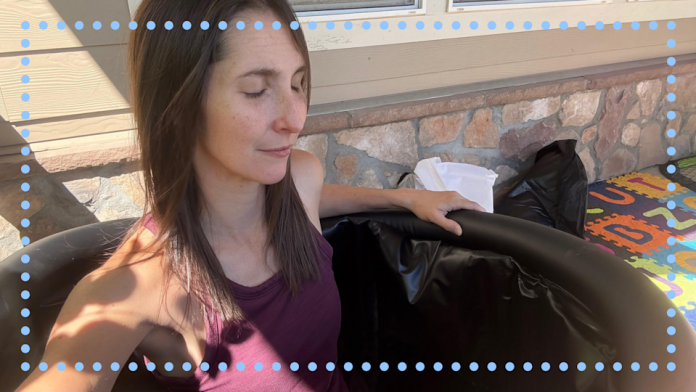Cold plunging: The key to faster recovery and better health? Or a pricey way to freeze your buns off? As a registered dietitian, wellness editor and avid podcast listener, I’ve been curious about ice baths for several years now. I initially wrote them off as a fad (oftentimes an expensive one) that would slowly melt away, making space for the next “it” trend. Yet, one day, I was listening to Good Hang with Amy Poehler, and she mentioned that she’s been cold plunging daily for almost a year. This, combined with several friends boasting about their fancy gyms offering spa-worthy cold plunge tubs, left me wondering: Are at-home cold plunges actually worth the price and the discomfort?
To find out, I put two very different ice baths to the test: The more DIY-style (and budget-friendly) Cold Pod and the pricey, tech-forward Plunge Air. Despite being a fan of steamy showers (and hot-tailing it out when pools are too cold), I mustered up the courage and took icy dips over the course of two months. Here’s what I found.
Related: Prefer recovery options that don’t require an icy plunge? Check out our lists of the best foam rollers and massage guns.
Before the plunge: Fears and expectations
My main fear around cold plunging was one that I’m sure most of us have when faced with the idea of sitting in very cold water: Just how uncomfortably cold will I be? Our resistance to that spine-tingling chill when a foot first hits cold water is a funny thing. The body instantly flashes a “do not enter” signal to the brain. But what if, like wading into a cold pool or lake, the shock fades quickly, and plunging isn’t actually that bad?
Advertisement
Advertisement
Reminding myself that it would only last a few seconds — maybe a couple of minutes — I decided to give the trend a try and see if it could ease my post-workout soreness, especially after leg days when climbing the stairs feels impossible. (You can learn more about the science and potential benefits of ice baths here.)
The first plunge
To help your body adjust to the temperature, it’s recommended that you slowly submerge yourself while using deep breathing techniques.
(Kelli McGrane, MS, RD)
I was pretty hesitant about taking the first plunge and kept asking myself why I’d volunteered to test these icy baths. Following Cold Pod’s recommendation, I started with just cold hose water and no ice. Going slow wasn’t just about comfort — it also gave me time to practice my stance in the barrel-style tub while focusing on deep breathing (which is where my yoga practice came in handy). To my surprise, I felt relaxed in the water, and after two minutes, I stepped out refreshed and ready to take on colder temps.
I noticed benefits, but not the ones I expected
As I started adding ice to my plunges and the water temperature progressively dropped, my time in the plunge also dipped. However, I found the increased intensity of the experience came with a bigger payoff: A rush of energy and a mood boost. In terms of recovery, I honestly didn’t notice much difference compared to using a foam roller or one of my trusty heating pads. What set the ice bath apart, though, was the immediate surge of energy that I then carried into my day.
Even on mornings when I hadn’t exercised, plunging before work left me feeling sharper, more focused and ready to type away on articles. Beyond the added energy, the icy shock also helped interrupt anxiety spirals, giving me enough calm to use the tools and techniques I’ve been practicing in therapy.
With a different schedule, I could see it becoming a regular part of my routine
There were two main barriers. The first: time. As a single mom juggling a full-time job and two different school drop-offs, free moments are rare. While the plunge itself is quick, my workout schedule is inconsistent — which may explain why I didn’t notice major recovery benefits — and I often don’t have time to change in and out of a bathing suit. The Cold Pod also required an added layer of prep since it requires DIY cooling, and remembering to make or buy ice wasn’t always easy. With a more predictable routine, I’d love to see how consistent plunging could impact both my mental and physical health.
Be ready for the maintenance
The Plunge Air requires special cleaners to keep it clean and safe to use.
(Kelli McGrane, MS, RD)
The time and money you’ll spend maintaining an ice bath largely depends on the model. For example, the Cold Pod requires regular draining and a quick clean with soapy water. In contrast, higher-end options like the Plunge Air come with built-in filters, so they don’t need to be drained as often. Instead, they require upkeep similar to a hot tub, including filter changes and chemicals to maintain the right pH. Depending on your schedule and budget, neither may feel like a deal-breaker — but if you’re already juggling work, cleaning and meal prep, adding yet another responsibility might not be at the top of your list.
Curious to try it? Here’s what you’ll need
Our health content is for informational purposes only and is not intended as professional medical advice. Consult a medical professional on questions about your health.









